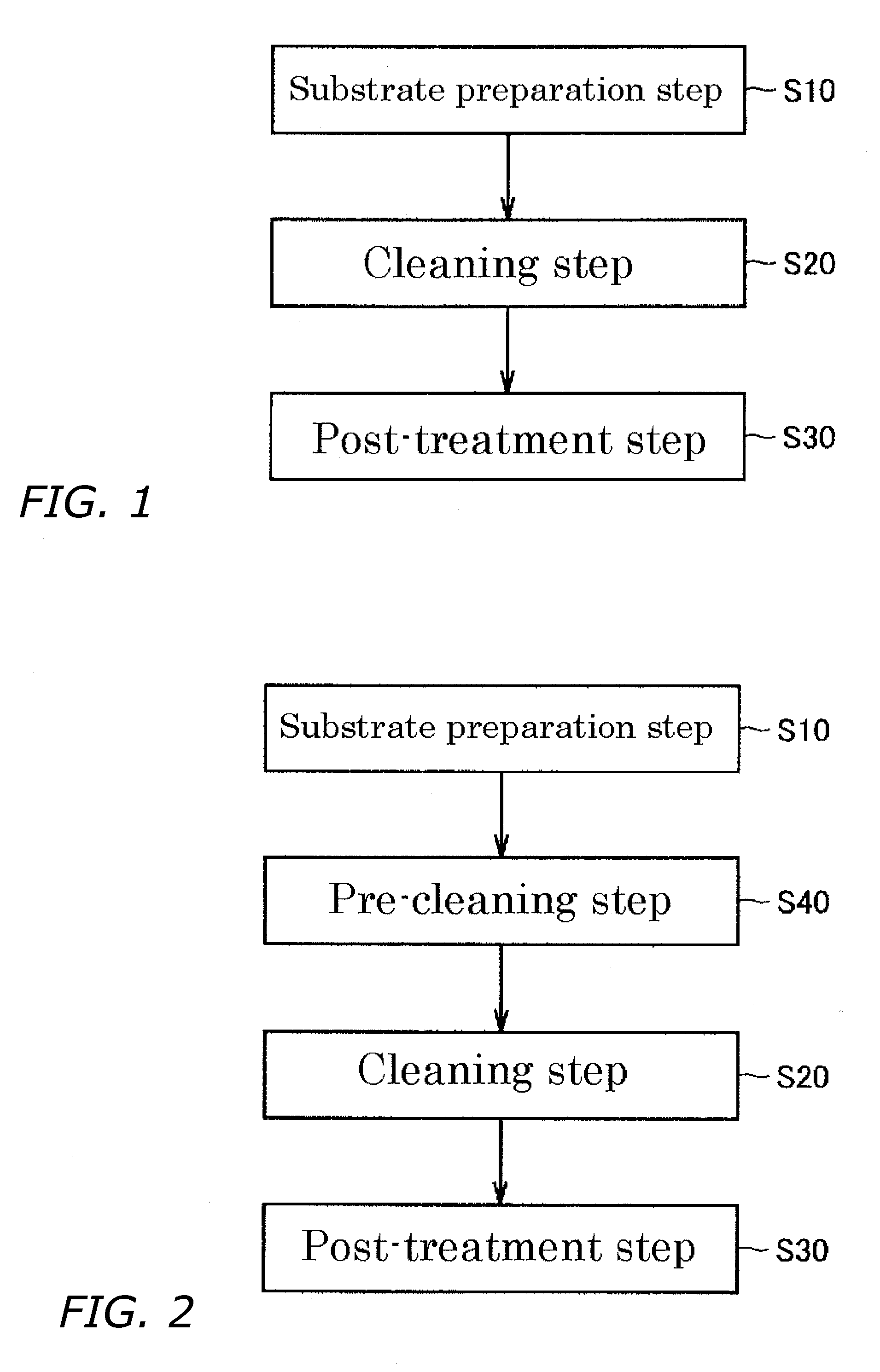Method of Surface Treating Substrates and Method of Manufacturing III-V Compound Semiconductors
a surface treatment and semiconductor technology, applied in the direction of packaging foodstuffs, pharmaceutical containers, packaged goods types, etc., can solve the problems of high cost, high cost, and high cost, and achieve the effect of reducing haze, reducing micro-roughness of the surface, and improving cleaning ability
- Summary
- Abstract
- Description
- Claims
- Application Information
AI Technical Summary
Benefits of technology
Problems solved by technology
Method used
Image
Examples
embodiment 1
[0033]FIG. 1 is a flow chart showing a method of surface treating a substrate in Embodiment 1 of the present invention. Referring to FIG. 1, the substrate surface treating method in Embodiment 1 of the present invention will be described.
[0034] As shown in FIG. 1, a substrate preparation step (S10) is performed first in the substrate surface treating method in Embodiment 1, in which a substrate composed of Group III-V compound is prepared. The prepared substrate may be a bulk crystal or a thin film formed on a substrate made of a bulk crystal, for example.
[0035] Next, a cleaning step (S20) is performed. In the cleaning step (S20), the substrate is cleaned with a cleaning solution whose pH has been adjusted to be acidic from 2 to 6.3 inclusive and to which an oxidizing agent has been added. It is preferable that as the cleaning solution a cleaning solution composed of DI water (a cleaning solution composed of DI water in which pH has been adjusted to be acidic from 2 to 6.3 inclusi...
embodiment 2
[0043]FIG. 2 is a flow chart that shows a substrate surface treating method in Embodiment 2 of the present invention. Referring to FIG. 2, the substrate surface treating method in Embodiment 2 of the present invention will be described.
[0044] As shown in FIG. 2, the substrate surface treating method (cleaning method) in Embodiment 2 has basically steps similar to those of the substrate surface treating method in Embodiment 1 of the present invention.
[0045] More specifically, in a pre-cleaning step (S40), before the cleaning step (S20), the substrate is cleaned with an alkaline cleaning solution. The pre-cleaning step (S40) may include a chemical cleaning step, a rinsing step (DI water rinsing step), and a drying step. The chemical cleaning step and the rinsing step (DI water rinsing step) can be repeated several times, if necessary.
[0046] In the pre-cleaning step (S40), in order to remove impurities from the surface of the substrate composed of Group III-V compound semiconductor,...
embodiment 3
[0048] Referring to FIG. 2, a substrate surface treating method in Embodiment 3 of the present invention will be described. As shown in FIG. 2, the substrate surface treating method (cleaning method) in Embodiment 3 has basically steps similar to those of the substrate surface treating method in Embodiment 2 of the present invention.
[0049] Specifically, the cleaning step (S20) includes a rinse step of cleaning the substrate with DI water to which ultrasonic wave is being applied. In the rinse step, vibrations or shaking is applied to the cleaning solution using a ultrasonic device, as shown in FIG. 3, for example.
[0050] More specifically, the cleaning step (S20) may include a chemical cleaning step, a rinse step, and a drying step. The chemical cleaning step and the rinse step can be repeated several times, if required.
[0051]FIG. 3 is a schematic cross sectional view of showing a processing apparatus used for the rinse step. Referring to FIG. 3, the processing apparatus used for ...
PUM
 Login to View More
Login to View More Abstract
Description
Claims
Application Information
 Login to View More
Login to View More - R&D
- Intellectual Property
- Life Sciences
- Materials
- Tech Scout
- Unparalleled Data Quality
- Higher Quality Content
- 60% Fewer Hallucinations
Browse by: Latest US Patents, China's latest patents, Technical Efficacy Thesaurus, Application Domain, Technology Topic, Popular Technical Reports.
© 2025 PatSnap. All rights reserved.Legal|Privacy policy|Modern Slavery Act Transparency Statement|Sitemap|About US| Contact US: help@patsnap.com



